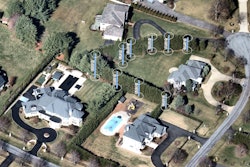 Photo: Bobcat
Photo: BobcatSelecting the right compact excavator for your landscaping company can be an overwhelming task when you have multiple manufacturers and specs to consider.
Compact excavators are excellent tools to have on the jobsite thanks to their versatility and ability to reduce the need for hand labor.
If you are considering adding one to your fleet, or if you’re shopping for a new one, here are the questions you should be asking and what really matters when trying to narrow down your options.
Do I need a compact excavator?
It may sound like a no-brainer, but machinery is a big investment, so it is important to not end up buying something your business doesn’t really need.
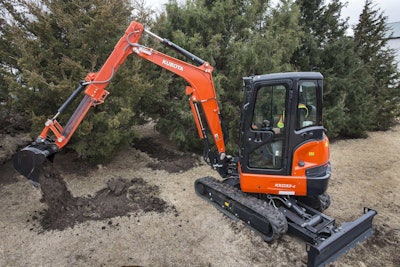 Compact excavators are known for their versatility on the jobsite.
Compact excavators are known for their versatility on the jobsite.Photo: Kubota
Compact excavators can be used for jobs such as digging trenches for irrigation systems, moving brush, grading, making holes for posts and trees and much more if the right attachment is used.
“When properly matched to the project; there really are no limitations to what these machines can do,” says Jeff Jacobsmeyer, Kubota product manager for excavators, wheel loaders and TLBs. “Advanced load sensing hydraulics with an adjustable auxiliary flow allows the operator to ‘dial’ in the flow rate needed for any attachment.”
Bucket and thumb attachments are two of the most commonly used for compact excavators, as they enable the user to manipulate irregularly shaped objects, debris and rocks. Other popular attachments include augers, hammers and variously sized buckets.
If you’ve already been renting a compact excavator for the majority of your jobs, this is a good indicator it will be put to good use if you buy one, and it may even enable you to pick up more of these jobs after purchasing one for your business.
What are the specs?
Once you’ve determined a compact excavator would fit well in your operations, there are a number of specs to evaluate.
The nature of your work will determine which specs you’ll really need to pay attention to, but the two main details you should focus on are the listed dig depth and lifting capacity.
According to Jacobsmeyer, it is not often that a landscaper will need to dig to the machine’s maximum depth. For the most part, a machine with a dig depth of +/- 10’ will work within the range of 0-9’ over 95 percent of the time.
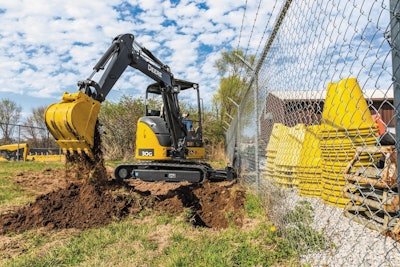 Digging depth and lift capacity are two important specs to note.
Digging depth and lift capacity are two important specs to note.Photo: John Deere
“When considering the dig depth and lift capacity you need for the work you typically do, don’t forget your business will likely expand into larger, more complex jobs,” says Justin Steger, inside district manager, compact construction equipment, for John Deere. “Purchasing a compact excavator that is capable of lifting and digging 25 percent more than what you typically do today, will allow your business to grow without having to replace equipment as fast.”
As for the specs that can be deceiving, Steger says engine horsepower is one of those “look at me” specifications. It is important to note if the listed horsepower is gross or net. Net horsepower will be the more realistic number, taking into account inefficiencies.
“Arguably more important than engine horsepower is hydraulic horsepower – even though both are related,” Steger says. “Compact excavators are hydraulically operated, and a high engine horsepower machine with less efficient hydraulic pumps to transfer that power may not feel as powerful as a machine with slightly less horsepower and more efficient hydraulics.”
An excavator’s hydraulic system contributes to its performance more than any other feature, according to Jason Boerger, marketing manager for Bobcat Company.
“In other words, hydraulic horsepower, in working conditions, is key to measuring the machine’s overall hydraulic system performance,” Boerger said. “Hydraulic horsepower also plays a major role in cycle times and attachment performance.”
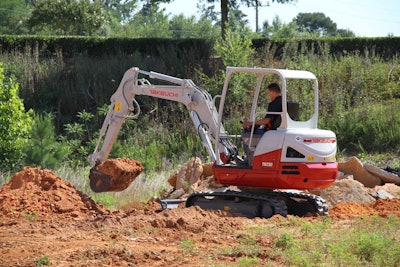 The hydraulic system will determine how well the excavator runs certain attachments.
The hydraulic system will determine how well the excavator runs certain attachments.Photo: Takeuchi
Lee Padgett, a product manager for Takeuchi, says that also flow rate and the amount of hydraulic oil in the system should be considered.
“Higher flow allows for a wider range of attachments to be utilized, and higher oil capacity should allow oil temperatures to remain lower, which would improve the durability of hydraulic components,” Padgett says.
Another key aspect to keep in mind is the size of the jobs you are working on, as this will help you determine what type of tail swing is best for your jobs. Between conventional, reduced and zero tail swing, there is no one perfect type. Everything has a tradeoff, Steger says.
The main difference comes down to how the machine’s upper structure rotates, how much the excavator housing extends past the tracks and the width of the tracks.
“Conventional tail swing machines typically have a narrower undercarriage, giving them better access than a zero tail swing machine that has a wider undercarriage to help stabilize it,” Padgett says. “Additional benefits of the conventional design are more spacious cabins and better maintenance access.”
Conventional tail swing excavators typically offer the greatest lift capacity and the rear of the house protrudes 6-20 inches during rotation.
A reduced or minimal tail swing excavator’s chassis extends no more than 6 inches beyond the tracks and is a good option for when there is not a lot of room to maneuver.
 Zero tail swing enables landscapers to work in tight spaces.
Zero tail swing enables landscapers to work in tight spaces.Photo: John Deere
“Minimum tail swing machines may sacrifice a bit in side stability lifting, but the operator never has to worry about damaging the rear of the machine or other surroundings since the weight is tucked in closer to the center axis of the excavator,” Jacobsmeyer says.
Zero tail swing excavators can work in tightly cramped spaces, but it also results in a reduced reach, reduced dig depth and rated operating capacity. As for which tail swing works best for you will come down to the nature of your job sites.
When it comes to weight, compact excavators are classified anywhere from 0 to 6 metric tons, while the mid-sized excavators can weigh anywhere between 6 to 10 metric tons.
The most popular weight amongst landscapers is in the 3-4 metric ton size class.
“This size of machine is typically the largest compact excavator that can be hauled on a trailer without having to have a commercial driver’s license,” Jacobsmeyer says. “The compact size allows for close work in areas resulting in less collateral damage to the surroundings when performing underground repairs or remodels near existing landscapes or structures.”
What are the other benefits?
While specs like digging depth, lift capacity and tail swing configuration are important, they are not the only factors you should take into consideration.
You may think the features in the operator cab are superfluous but after spending a long day running equipment, your crews will thank you for including those elements that improve the user experience.
“Some cab features such as A/C or a suspension seat could be viewed as unnecessary to digging functions but make the operator much more comfortable, causes less fatigue and in some cases more productive,” Padgett says.
Another facet you might not have considered in the buying process is the dealer support.
“Downtime costs a landscaper money, but even for basic maintenance, you want to choose a dealer that has parts on hand and is available for service and support should you need them,” Steger says.
When can I run a demo?
Last, but definitely not least, do not forget to put your potential new compact excavator to the test. While you can determine a fair amount about the hydraulics of the machine from a spec sheet, some things you can only discover by running a demo.
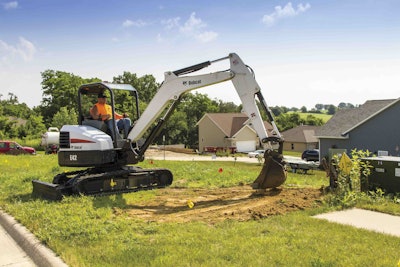 Demoing the equipment is the only way you’ll know for sure how the excavator will do out in the field.
Demoing the equipment is the only way you’ll know for sure how the excavator will do out in the field.Photo: Bobcat
“Hydraulic flow is important, auxiliary hydraulic flow is important depending on the attachments you plan to use, but I would argue the ability to multifunction is the most important – and doesn’t show up on a spec sheet or brochure,” Steger says. “How the hydraulic system functions as a whole while you are commanding the bucket, arm, boom and swing all together is something you can determine by demoing machines and seeing which one works best for you.”
Asking your local compact equipment dealer to bring an excavator to your landscaping site can help you put the machine through its paces by conducting real-life situations such as trenching or lifting boulders.
“While specs are very important to take into consideration when looking to purchase a compact excavator – and can help narrow down the choices – they shouldn’t be the only thing that is looked at,” Boerger says. “It’s very important to get into the machine and operate it to see how it feels and performs. Just like you wouldn’t buy a car without test driving it first, you shouldn’t buy a compact excavator without doing the same.”




